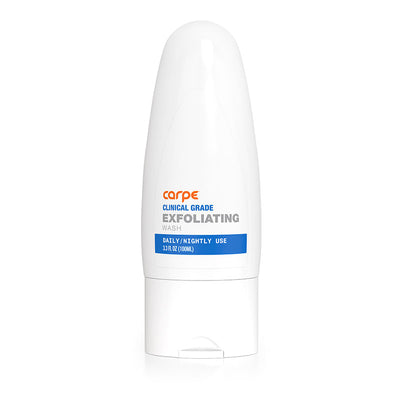Sweating is a normal, healthy occurrence if it helps your body to cool itself down. However, some people experience excessive sweating that is burdensome rather than beneficial. This is especially problematic when sweat accumulates on certain parts of the body - like the groin. If you experience the following symptoms it could be a sign that your groin sweating has become excessive and may require some intervention:
So, what causes this type of unsettling groin sweat production? There are many possible culprits. Keep reading to learn about the most common causes![1][2]
Primary Focal Hyperhidrosis
Hyperhidrosis is the medical term used to describe unusual, excessive sweating that is not related to the heat or exertion. The two most common types of hyperhidrosis are called primary focal hyperhidrosis and secondary generalized hyperhidrosis. Most commonly, night sweats are a symptom of secondary hyperhidrosis - which is a type of hyperhidrosis caused by an underlying medical condition or medication. For example, some medications cause excessive sweating as a side effect. Due to the fact that the excessive sweating has a causative agent, the medication, a person would be said to have secondary hyperhidrosis. In contrast, primary focal hyperhidrosis develops earlier on in life and has no causative factor.[3] While primary focal hyperhidrosis could potentially cause night sweats, this is much less common.[1] The other causes of night sweats discussed in this article are actually types of secondary generalized hyperhidrosis.
Pregnancy and Menopause
One of the most common causes of excessive groin sweating is called primary focal hyperhidrosis (PFH). Hyperhidrosis is a skin disorder that causes sweating to occur in excess of what is needed by the body for normal physiological functioning. Most of the time, primary focal hyperhidrosis affects specific areas of the body like the hands, feet, armpits, face, and less commonly, the groin. A specific type of PFH called Hexsel’s hyperhidrosis is used to describe the condition when hyperhidrosis specifically affects the inguinal (groin) region. People with this type of hyperhidrosis usually struggle with sweating on the upper thighs, suprapubic area, external genitalia, gluteal folds, and the gluteal cleft. Sweating can become so severe that patients often experience soaking their clothes and deal with embarrassing situations as a result.[3]
Researchers aren’t sure how many people struggle with primary focal hyperhidrosis that causes excessive groin sweating. It is thought to be less than the population of people that have hyperhidrosis that affects other parts of the body. One retrospective chart review published in the journal of Dermatologic Clinics observed that only 1.3% of the patients reviewed experienced groin sweating. It is known that about 50% of patients who have Hexsel’s hyperhidrosis have a family history of the condition, leading doctors to believe that there is at least some heritable component to hyperhidrosis. No one is sure why people develop primary focal hyperhidrosis, but it typically begins during puberty and can affect a person over their lifetime. While there is no cure for hyperhidrosis, there are ways to stop or decrease groin sweating.[3]
Secondary Generalized Hyperhidrosis
Secondary generalized hyperhidrosis is excessive sweating that is caused by an underlying factor like a medical condition or medication. Typically the sweating from this type of hyperhidrosis causes sweating to occur evenly all over the body and it can appear suddenly during any stage of life. Secondary hyperhidrosis is not known to only affect the groin area, but it can certainly cause excessive groin sweating. People with this type of hyperhidrosis often also experience night sweating in contrast to those with primary focal hyperhidrosis.[3]
There are several possible causes of secondary generalized hyperhidrosis. Below is a list of conditions that could possibly cause secondary hyperhidrosis:
There are several other factors that can cause secondary hyperhidrosis, some of which are benign and others that are medically serious. Therefore, if you think you might have secondary hyperhidrosis it is important that you speak to a doctor about the potential causes. Luckily, secondary hyperhidrosis can be fixed by treating the underlying condition or stopping the medication that is causing it.[3]
Other Factors
While lifestyle factors aren’t going to cause excessive groin sweating to the point of needing medical attention, they can make a bad problem worse. You might be experiencing increased groin sweat production if you are wearing underwear that are tight, constricting, or made of fabrics with moisture-retentive properties. As unimportant as this may seem, it can actually be an important factor for some people. Exercise is another reason some people experience excessive groin sweating. So, if your sweat is only an issue after you are physically active then you probably don’t have a problem but you may want to dress accordingly. Finally, other lifestyle factors like obesity and pubic grooming can lead to differences in sweat production.[4]
If you are struggling with excessive groin sweat then don’t give up! It can be difficult to find a treatment that works for you, but there are options available. There are treatments that allow patients to control groin sweat and that will help you to move on from the stress that excessive sweating causes.
Sources
- Is the Sweating Between My Legs Excessive? (n.d.). Retrieved August 14, 2019, from https://www.healthline.com/health/how-do-i-stop-sweating-between-my-legs
- Sweating and body odor. (2017, February 14). Retrieved August 14, 2019, from https://www.mayoclinic.org/diseases-conditions/sweating-and-body-odor/symptoms-causes/syc-20353895
- Pariser, D. M. (2014). Hyperhidrosis (4th ed., Vol. 32). Philadelphia, PA: Elsevier.
- Eske, J. (2018, November 16). What causes sweating around the vagina? Retrieved August 14, 2019, from https://www.medicalnewstoday.com/articles/323719.php






16790753702383.jpg?v=1679075372)

16790746985853.jpg?v=1679074700)


16790757289763.jpg?v=1679075731)









